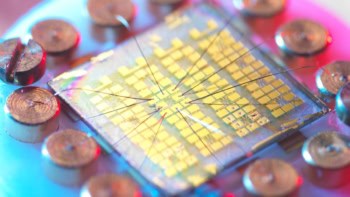A successful solid-state quantum computer will have to ‘entangle’ quantum bits – or ‘qubits’ - over macroscopic distances. However, entanglement in solid-state systems has only been observed on the micrometre scale so far. Now, Andrew Berkley and colleagues from the University of Maryland have entangled two solid-state superconducting qubits over a distance of 0.7 mm – a thousand times greater than ever before (A J Berkley et al. 2003 Sciencexpress 1084528 ).
A quantum computer could, in principle, outperform a classical computer by exploiting the ability of a quantum system to be in two states – often called 0 and 1 – at the same time. When two qubits are entangled, they behave as one system: this means that the quantum state of one qubit directly depends on the state of the other. It was once thought that entanglement was only possible with individual quantum particles – such as photons – but recent experiments have shown that macroscopic objects can also be entangled. Superconducting materials are good for making qubits because decoherence effects – which wipe out quantum behaviour – can be limited.
Berkley and co-workers made their qubits from a Josephson Junction – a type of superconducting ‘reservoir’ – and coupled two qubits together using a capacitor. Under certain conditions, the qubits can exist in one of two states: a ground state or an excited state. When the two qubits are entangled, if qubit 1 is in the ground state then qubit 2 is in the excited state, and vice versa.
The researchers measured the entangled states by applying microwaves to the system and recording transitions from the ground state to higher energy states. “Such evidence for entanglement over a macroscopic length is particularly promising for the construction of a quantum computer, as this will require many spatially separated qubits,” said Berkley.



